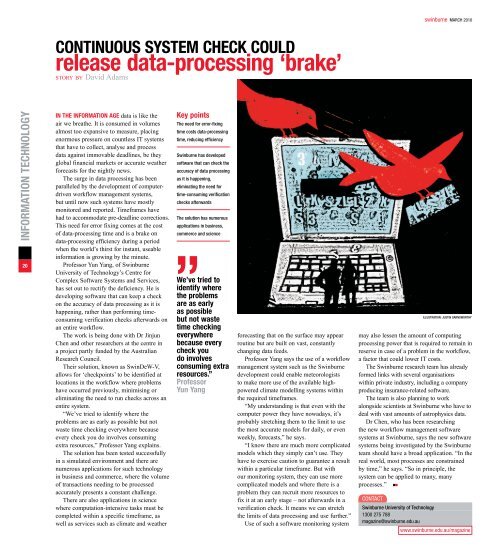March 2010 - Swinburne University of Technology
March 2010 - Swinburne University of Technology
March 2010 - Swinburne University of Technology
You also want an ePaper? Increase the reach of your titles
YUMPU automatically turns print PDFs into web optimized ePapers that Google loves.
swinburne <strong>March</strong> <strong>2010</strong><br />
Continuous system check could<br />
release data-processing ‘brake’<br />
story by David Adams<br />
information technology<br />
20<br />
In the information age data is like the<br />
air we breathe. It is consumed in volumes<br />
almost too expansive to measure, placing<br />
enormous pressure on countless IT systems<br />
that have to collect, analyse and process<br />
data against immovable deadlines, be they<br />
global financial markets or accurate weather<br />
forecasts for the nightly news.<br />
The surge in data processing has been<br />
paralleled by the development <strong>of</strong> computerdriven<br />
workflow management systems,<br />
but until now such systems have mostly<br />
monitored and reported. Timeframes have<br />
had to accommodate pre-deadline corrections.<br />
This need for error fixing comes at the cost<br />
<strong>of</strong> data-processing time and is a brake on<br />
data-processing efficiency during a period<br />
when the world’s thirst for instant, useable<br />
information is growing by the minute.<br />
Pr<strong>of</strong>essor Yun Yang, <strong>of</strong> <strong>Swinburne</strong><br />
<strong>University</strong> <strong>of</strong> <strong>Technology</strong>’s Centre for<br />
Complex S<strong>of</strong>tware Systems and Services,<br />
has set out to rectify the deficiency. He is<br />
developing s<strong>of</strong>tware that can keep a check<br />
on the accuracy <strong>of</strong> data processing as it is<br />
happening, rather than performing timeconsuming<br />
verification checks afterwards on<br />
an entire workflow.<br />
The work is being done with Dr Jinjun<br />
Chen and other researchers at the centre in<br />
a project partly funded by the Australian<br />
Research Council.<br />
Their solution, known as SwinDeW-V,<br />
allows for ‘checkpoints’ to be identified at<br />
locations in the workflow where problems<br />
have occurred previously, minimising or<br />
eliminating the need to run checks across an<br />
entire system.<br />
“We’ve tried to identify where the<br />
problems are as early as possible but not<br />
waste time checking everywhere because<br />
every check you do involves consuming<br />
extra resources,” Pr<strong>of</strong>essor Yang explains.<br />
The solution has been tested successfully<br />
in a simulated environment and there are<br />
numerous applications for such technology<br />
in business and commerce, where the volume<br />
<strong>of</strong> transactions needing to be processed<br />
accurately presents a constant challenge.<br />
There are also applications in science<br />
where computation-intensive tasks must be<br />
completed within a specific timeframe, as<br />
well as services such as climate and weather<br />
Key points<br />
The need for error-fixing<br />
time costs data-processing<br />
time, reducing efficiency<br />
<strong>Swinburne</strong> has developed<br />
s<strong>of</strong>tware that can check the<br />
accuracy <strong>of</strong> data processing<br />
as it is happening,<br />
eliminating the need for<br />
time-consuming verification<br />
checks afterwards<br />
The solution has numerous<br />
,,<br />
applications in business,<br />
commerce and science<br />
We’ve tried to<br />
identify where<br />
the problems<br />
are as early<br />
as possible<br />
but not waste<br />
time checking<br />
everywhere<br />
because every<br />
check you<br />
do involves<br />
consuming extra<br />
resources.”<br />
Pr<strong>of</strong>essor<br />
Yun Yang<br />
forecasting that on the surface may appear<br />
routine but are built on vast, constantly<br />
changing data feeds.<br />
Pr<strong>of</strong>essor Yang says the use <strong>of</strong> a workflow<br />
management system such as the <strong>Swinburne</strong><br />
development could enable meteorologists<br />
to make more use <strong>of</strong> the available highpowered<br />
climate modelling systems within<br />
the required timeframes.<br />
“My understanding is that even with the<br />
computer power they have nowadays, it’s<br />
probably stretching them to the limit to use<br />
the most accurate models for daily, or even<br />
weekly, forecasts,” he says.<br />
“I know there are much more complicated<br />
models which they simply can’t use. They<br />
have to exercise caution to guarantee a result<br />
within a particular timeframe. But with<br />
our monitoring system, they can use more<br />
complicated models and where there is a<br />
problem they can recruit more resources to<br />
fix it at an early stage – not afterwards in a<br />
verification check. It means we can stretch<br />
the limits <strong>of</strong> data processing and use further.”<br />
Use <strong>of</strong> such a s<strong>of</strong>tware monitoring system<br />
illustration: Justin Garnsworthy<br />
may also lessen the amount <strong>of</strong> computing<br />
processing power that is required to remain in<br />
reserve in case <strong>of</strong> a problem in the workflow,<br />
a factor that could lower IT costs.<br />
The <strong>Swinburne</strong> research team has already<br />
formed links with several organisations<br />
within private industry, including a company<br />
producing insurance-related s<strong>of</strong>tware.<br />
The team is also planning to work<br />
alongside scientists at <strong>Swinburne</strong> who have to<br />
deal with vast amounts <strong>of</strong> astrophysics data.<br />
Dr Chen, who has been researching<br />
the new workflow management s<strong>of</strong>tware<br />
systems at <strong>Swinburne</strong>, says the new s<strong>of</strong>tware<br />
systems being investigated by the <strong>Swinburne</strong><br />
team should have a broad application. “In the<br />
real world, most processes are constrained<br />
by time,” he says. “So in principle, the<br />
system can be applied to many, many<br />
processes.” ••<br />
Contact. .<br />
<strong>Swinburne</strong> <strong>University</strong> <strong>of</strong> <strong>Technology</strong><br />
1300 275 788<br />
magazine@swinburne.edu.au<br />
www.swinburne.edu.au/magazine
















